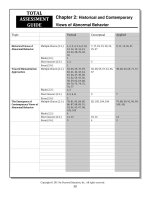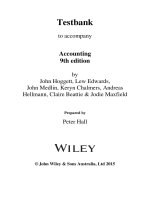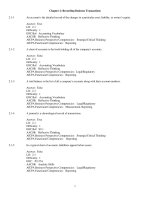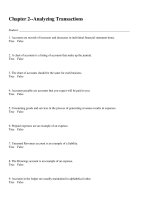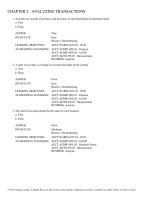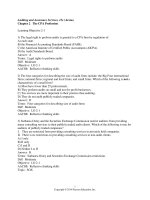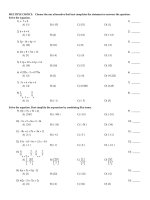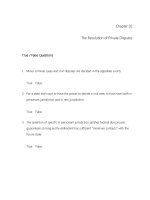Intermediate accounting 15th edition kieso test bank
Bạn đang xem bản rút gọn của tài liệu. Xem và tải ngay bản đầy đủ của tài liệu tại đây (370.07 KB, 33 trang )
CHAPTER 2
CONCEPTUAL FRAMEWORK FOR FINANCIAL
REPORTING
IFRS questions are available at the end of this chapter.
TRUE-FALSE—Conceptual
Answer
T
T
F
T
F
T
F
T
T
F
F
F
T
T
F
F
T
T
F
F
No.
Description
1.
2.
3.
4
5.
6.
7.
8.
9.
10.
11.
12.
13.
14.
15.
16.
17.
18.
19.
20.
Nature of conceptual framework.
Conceptual framework definition.
Levels of conceptual framework.
International conceptual framework.
Statements of Financial Accounting Concepts.
Objective of financial reporting.
Financial statement users.
Relevance and faithful representation.
Consistency.
Relevance.
Faithful representation.
Basic elements.
Comprehensive income.
Going concern assumption.
Economic entity assumption.
Expense recognition principle.
Recognizable revenues.
Supplementary information.
Cost benefit trade-off.
Conservatism.
MULTIPLE CHOICE—Conceptual
Answer
c
d
c
d
d
d
a
d
a
a
a
b
c
c
a
No.
21.
22.
23.
24.
S
25.
26.
27.
28.
29.
P
30.
S
31.
32.
33.
34.
35.
Description
GAAP defined.
Purpose of conceptual framework.
Conceptual framework.
Conceptual framework purpose.
Conceptual framework benefits.
Objectives of financial reporting.
Decision usefulness.
General purpose of financial reporting.
Primary objective of financial reporting.
Example of comparability.
Primary quality of relevance.
Characteristic of accounting information.
Characteristic of accounting information.
Meaning of comparability.
Meaning of consistency.
2-2
Test Bank for Intermediate Accounting, Fifteenth Edition
MULTIPLE CHOICE—Conceptual
Answer
d
c
a
b
d
a
d
a
c
b
b
d
c
d
b
d
c
a
c
d
b
b
d
d
c
c
d
b
d
b
a
b
a
d
c
d
c
b
b
a
c
c
d
a
b
a
d
d
a
No.
36.
37.
38.
39.
40.
41.
42.
43.
44.
45.
46.
47.
48.
49.
50.
51.
52.
53.
54.
55.
56.
57.
58.
59.
60.
61.
62.
63.
P
64.
S
65.
S
66.
67
68.
69.
70.
71.
72.
73
74.
S
75.
S
76.
77.
78.
79.
80.
81.
82.
83.
84.
Description
Ingredient of relevance.
Ingredient of reliability.
Consistency characteristic.
Primary quality of accounting information.
Quality of relevance.
Quality of reliability.
Consistency quality.
Decision-usefulness criterion.
Primary qualities of accounting information.
Definition of relevance.
Definition of reliability.
Relevance quality.
Materiality characteristic.
Completeness characteristic.
Neutrality characteristic.
Neutrality characteristic.
Definition of verifiability.
Quality of predictive value.
Quality of free from error.
Consistency.
Consistency characteristic.
Comparability and consistency.
Comparability.
Elements of financial statements.
Distinction between revenues and gains.
Definition of a loss.
Definition of comprehensive income.
Components of comprehensive income.
Comprehensive income.
Earnings vs. comprehensive income.
Reporting financial statement elements.
Basic element of financial statements.
Basic element of financial statements.
Basic element of financial statements.
Definition of gains.
Historical cost assumption.
Periodicity assumption.
Going concern assumption.
Periodicity assumption.
Monetary unit assumption.
Periodicity assumption.
Monetary unit assumption.
Economic entity assumption.
Economic entity assumption.
Periodicity assumption.
Going concern assumption.
Going concern assumption.
Implications of going concern assumption.
Historical cost principle.
(cont.)
Conceptual Framework Underlying Financial Accounting
MULTIPLE CHOICE—Conceptual
Answer
d
c
d
d
d
c
b
b
b
b
c
a
d
b
c
a
d
c
a
d
c
a
d
c
a
c
d
c
b
a
d
a
c
d
d
a
b
a
c
c
No.
85.
86.
87.
88.
89.
90.
91.
92.
93.
94.
95.
96.
97.
98.
99.
100.
101.
102.
103.
104.
105.
106.
107.
108.
109.
110.
111.
112.
113.
114.
115.
116.
117.
118.
119.
120.
121.
122.
123.
P
124.
(cont.)
Description
Historical cost principle.
Revenue recognition principle.
Revenue recognition principle.
Revenue recognition principle.
Measurement principle.
Expense recognition principle.
Product costs.
Expense recognition principle.
Expense recognition principle.
Expense recognition.
Full-disclosure principle.
Argument against historical cost.
Recognition of revenue.
Revenue recognition principle.
Definition of performance obligation.
Required components of financial statements.
Recognition of expenses.
Historical cost principle.
Expense recognition principle example.
Recording expenditure as asset.
Historical cost principle violation.
Full disclosure principle violation.
Full disclosure principle.
Historical cost principle violation.
Industry practice constraint.
Costs of providing financial information.
Benefits of providing financial information.
Use of materiality.
Definition of prudence/conservation.
Example of materiality constraint.
Constraints to limit the cost of reporting.
Cost-benefit relationship.
Materiality characteristic.
Materiality.
Pervasive constraints.
Prudence or conservatism.
Conceptual framework second level
Trade-offs between characteristics of accounting information.
Trade-offs between characteristics of accounting information.
Prudence or conservatism.
2-3
2-4
Test Bank for Intermediate Accounting, Fifteenth Edition
MULTIPLE CHOICE—CPA Adapted
Answer
a
b
b
b
a
b
d
d
a
P
S
No.
125.
126.
127.
128.
129.
130.
131.
132.
133.
Description
Quality of predictive value.
Relevance and faithful representation.
Classification of gains and losses.
Earnings concept.
Components of comprehensive income.
Components of comprehensive income.
Components of comprehensive income.
Components of comprehensive income.
Definition of recognition.
Note: these questions also appear in the Problem-Solving Survival Guide.
Note: these questions also appear in the Study Guide.
BRIEF EXERCISES
Item
BE2-134
BE2-135
BE2-136
Description
Qualitative characteristics.
Accounting concepts—identification.
Accounting concepts—identification.
EXERCISES
E2-137
E2-138
E2-139
E2-140
E2-141
Accounting concepts—matching.
Accounting concepts—fill in the blanks.
Basic assumptions.
Historical cost principle.
Matching concept.
CHAPTER LEARNING OBJECTIVES
1. Describe the usefulness of a conceptual framework.
2. Describe the FASB’s efforts to construct a conceptual framework.
3. Understand the objective of financial reporting.
4. Identify the qualitative characteristics of accounting information.
5. Define the basic elements of financial statements.
6. Describe the basic assumptions of accounting.
7. Explain the application of the basic principles of accounting.
Conceptual Framework Underlying Financial Accounting
8. Describe the impact that the cost constraint has on reporting accounting information.
9. Compare the conceptual frameworks underlying GAAP and IFRS.
2-5
2-6
Test Bank for Intermediate Accounting, Fifteenth Edition
SUMMARY OF LEARNING OBJECTIVES BY QUESTIONS
Item
Type
Item
Type
Item
1.
2.
TF
TF
21.
22.
MC
MC
23.
24.
3.
TF
4.
TF
5.
6.
7.
TF
TF
27.
28.
MC
MC
29.
134.
8.
9.
10.
11.
30.
31.
TF
TF
TF
TF
MC
MC
32.
33.
34.
35.
36.
37.
MC
MC
MC
MC
MC
MC
38.
39.
40.
41.
42.
43.
12.
13.
59.
TF
TF
MC
60.
61.
62.
MC
MC
MC
14.
15.
71.
TF
TF
MC
72.
73.
74.
MC
MC
MC
16.
17.
18.
84.
85.
86.
TF
TF
TF
MC
MC
MC
87.
88.
89.
90.
91.
92.
MC
MC
MC
MC
MC
MC
93.
94.
95.
96.
97.
98.
19.
20.
109.
TF
TF
MC
110.
111.
112.
MC
MC
MC
113.
114.
115.
1.
8.
15.
TF
TF
MC
2.
9.
16.
TF
TF
SA
Note:
P
63.
64.
S
65.
P
S
S
75.
76.
77.
Type
Item
Type
Item
Learning Objective 1
S
MC
25. MC
MC
134.
E
Learning Objective 2
TF
26. MC
94.
Learning Objective 3
MC
BE
Learning Objective 4
MC
44. MC
50.
MC
45. MC
51.
MC
46. MC
52.
MC
47. MC
53.
MC
48. MC
54.
MC
49. MC
55.
Learning Objective 5
S
MC
66. MC
69.
MC
67. MC
70.
MC
68. MC
127.
Learning Objective 6
MC
78. MC
81.
MC
79. MC
82.
MC
80. MC
83.
Learning Objective 7
MC
99. MC
105.
MC
100. MC
106.
MC
101. MC
107.
MC
102. MC
108.
MC
103. MC
133.
MC
104. MC
135.
Learning Objective 8
MC
116. MC
119.
MC
117. MC
120.
MC
118. MC
121.
Type
Item
Type
Item
Type
MC
MC
MC
MC
MC
MC
56.
57.
58.
125.
126.
135.
MC
MC
MC
MC
MC
BE
136.
137.
138.
BE
E
E
MC
MC
MC
128.
129.
130.
MC
MC
MC
131.
132.
MC
MC
MC
MC
MC
135.
138.
139.
BE
E
E
140.
E
MC
MC
MC
MC
MC
BE
136.
137.
138.
140.
141.
BE
E
E
E
E
MC
MC
MC
122.
123.
P
124.
MC
MC
MC
135.
136.
BE
BE
6.
13.
TF
MC
7.
14.
TF
MC
E
Learning Objective 9 – IFRS Questions
3. TF
4. TF
5. TF
10. TF
11. MC
12. MC
17. SA
TF = True-False
SA = Short Answer
MC = Multiple Choice BE = Brief Exercises
E = Exercise
Conceptual Framework Underlying Financial Accounting
2-7
TRUE-FALSE—Conceptual
1. A soundly developed conceptual framework enables the FASB to issue more useful and
consistent pronouncements over time.
2. A conceptual framework is a coherent system of concepts that flow from an objective.
3. The first level of the conceptual framework identifies the recognition, measurement, and
disclosure concepts used in establishing accounting standards.
4. The IASB has issued a conceptual framework and has agreed to develop a common
conceptual framework with the FASB.
5. Although the FASB has developed a conceptual framework, no Statements of Financial
Accounting Concepts have been issued to date.
6. The objective of financial reporting is the foundation of the conceptual framework.
7. Users of financial statements are assumed to need no knowledge of business and financial
accounting matters to understand information contained in financial statements.
8. Relevance and faithful representation are the two primary qualities that make accounting
information useful for decision making.
9. The idea of consistency does not mean that companies cannot switch from one accounting
method to another.
10. Timeliness and neutrality are two ingredients of relevance.
11. Verifiability and predictive value are two ingredients of faithful representation.
12. Revenues, gains, and distributions to owners all increase equity.
13. Comprehensive income includes all changes in equity during a period except those
resulting from investments by owners and distributions to owners.
14. The historical cost principle would be of limited usefulness if not for the going concern
assumption.
15. The economic entity assumption means that economic activity can be identified with a
particular legal entity.
16. The expense recognition principle states that debits must equal credits in each transaction.
17. Revenues are recognized in the accounting period in which the performance obligation is
satisfied.
18. Supplementary information may include details or amounts that present a different
perspective from that adopted in the financial statements.
2-8
Test Bank for Intermediate Accounting, Fifteenth Edition
19. In order to justify requiring a particular measurement or disclosure, the benefits to be
derived from it must equal the costs associated with it.
20. Prudence or conservatism means when in doubt, choose the solution that will be least likely
to overstate liabilities or expenses.
True False Answers—Conceptual
Item
1.
2.
3.
4.
5.
Ans.
T
T
F
T
F
Item
6.
7.
8.
9.
10.
Ans.
T
F
T
T
F
Item
11.
12.
13.
14.
15.
Ans.
F
F
T
T
F
Item
16.
17.
18.
19.
20.
Ans.
F
T
T
F
F
MULTIPLE CHOICE—Conceptual
21.
Generally accepted accounting principles
a. are fundamental truths or axioms that can be derived from laws of nature.
b. derive their authority from legal court proceedings.
c. derive their credibility and authority from general recognition and acceptance by the
accounting profession.
d. have been specified in detail in the FASB conceptual framework.
22.
A soundly developed conceptual framework of concepts and objectives should
a. increase financial statement users' understanding of and confidence in financial
reporting.
b. enhance comparability among companies' financial statements.
c. allow new and emerging practical problems to be more quickly solved.
d. All of these answer choices are correct.
23.
Which of the following is not true concerning a conceptual framework in accounting?
a. It should be a basis for standard-setting.
b. It should allow practical problems to be solved more quickly by reference to it.
c. It should be based on fundamental truths that are derived from the laws of nature.
d. All of these answer choices are true.
24.
What is a purpose of having a conceptual framework?
a. To enable the profession to more quickly solve emerging practical problems.
b. To provide a foundation from which to build more useful standards.
c. Neither a nor b.
d. To enable the profession to more quickly solve emerging practical problems and to
provide a foundation from which to build more useful standards.
Conceptual Framework Underlying Financial Accounting
S
P
2-9
25.
Which of the following is not a benefit associated with the FASB Conceptual Framework
Project?
a. A conceptual framework should increase financial statement users' understanding of
and confidence in financial reporting.
b. Practical problems should be more quickly solvable by reference to an existing
conceptual framework.
c. A coherent set of accounting standards and rules should result.
d. Business entities will need far less assistance from accountants because the financial
reporting process will be quite easy to apply.
26.
In the conceptual framework for financial reporting, what provides "the why"--the purpose
of accounting?
a. Recognition, measurement, and disclosure concepts such as assumptions, principles,
and constraints
b. Qualitative characteristics of accounting information
c. Elements of financial statements
d. Objective of financial reporting
27.
The underlying theme of the conceptual framework is
a. decision usefulness.
b. understandability.
c. faithful representation.
d. comparability.
28.
The objective of general-purpose financial reporting is to provide financial information
about a reporting entity to each of the following except
a. potential equity investors.
b. potential lenders.
c. present investors.
d. All of these answers are correct.
29.
What is the primary objective of financial reporting as indicated in the conceptual
framework?
a. Provide information that is useful to those making investing and credit decisions.
b. Provide information that is useful to management.
c. Provide information about those investing in the entity.
d. All of these answer choices are correct.
30.
If the LIFO inventory method was used last period, it should be used for the current and
following periods because of
a. comparability.
b. materiality.
c. timeliness.
d. verifiability.
2 - 10
S
Test Bank for Intermediate Accounting, Fifteenth Edition
31.
What is the following is a characteristic describing the primary quality of relevance?
a. Predictive value.
b. Materiality.
c. Verifiability.
d. Understandability.
32.
Which of the following is a fundamental quality of useful accounting information?
a. Comparability.
b. Relevance.
c. Neutrality.
d. Materiality.
33.
Which of the following is a primary quality of useful accounting information?
a. Conservatism.
b. Comparability.
c. Faithful representation.
d. Consistency.
34.
What is meant by comparability when discussing financial accounting information?
a. Information has predictive or confirmatory value.
b. Information is reasonably free from error.
c. Information that is measured and reported in a similar fashion across companies.
d. Information is timely.
35.
What is meant by consistency when discussing financial accounting information?
a. Information that is measured and reported in a similar fashion across points in time.
b. Information is timely.
c. Information is measured similarly across the industry.
d. Information is verifiable.
36.
Which of the following is an ingredient of relevance?
a. Verifiability.
b. Neutrality.
c. Timeliness.
d. Materiality.
37.
Which of the following is an ingredient of faithful representation?
a. Predictive value.
b. Materiality.
c. Neutrality.
d. Confirmatory value.
38.
Changing the method of inventory valuation should be reported in the financial statements
under what qualitative characteristic of accounting information?
a. Consistency.
b. Verifiability.
c. Timeliness.
d. Comparability.
39.
Company A issuing its annual financial reports within one month of the end of the year is
an example of which enhancing quality of accounting information?
a. Comparability.
Conceptual Framework Underlying Financial Accounting
2 - 11
b. Timeliness.
c. Understandability.
d. Verifiability.
40.
What is the quality of information that is capable of making a difference in a decision?
a. Faithful representation.
b. Materiality.
c. Timeliness.
d. Relevance.
41.
Neutrality is an ingredient of which fundamental quality of information?
a. Faithful representation.
b. Comparability.
c. Relevance.
d. Understandability.
42.
If the FIFO inventory method was used last period, it should be used for the current and
following periods because of
a. relevance.
b. neutrality.
c. understandability.
d. consistency.
43.
The pervasive criterion by which accounting information can be judged is that of
a. decision usefulness.
b. freedom from bias.
c. timeliness.
d. comparability.
44.
The two fundamental qualities that make accounting information useful for decision
making are
a. comparability and timeliness.
b. materiality and neutrality.
c. relevance and faithful representation.
d. faithful representation and comparability.
45.
Accounting information is considered to be relevant when it
a. can be depended on to represent the economic conditions and events that it is
intended to represent.
b. is capable of making a difference in a decision.
c. is understandable by reasonably informed users of accounting information.
d. is verifiable and neutral.
46.
The quality of information that means the numbers and descriptions match what really
existed or happened is
a. relevance.
b. faithful representation.
c. completeness.
d. neutrality.
2 - 12
Test Bank for Intermediate Accounting, Fifteenth Edition
47.
Which of the following does not relate to relevance?
a. Materiality
b. Predictive value
c. Confirmatory value
d. All of these answer choices relate to relevance.
48.
According to Statement of Financial Accounting Concepts No. 2, materiality is an ingredient
of the fundamental quality of
Relevance
Faithful Representation
a.
Yes
Yes
b.
No
Yes
c.
Yes
No
d.
No
No
49.
According to Statement of Financial Accounting Concepts No. 2, completeness is an
ingredient of the fundamental quality of
Relevance
Faithful Representation
a.
Yes
No
b.
Yes
Yes
c.
No
No
d.
No
Yes
50.
According to Statement of Financial Accounting Concepts No. 2, neutrality is an ingredient
of the fundamental quality of
Relevance
Faithful Representation
a.
Yes
Yes
b.
No
Yes
c.
Yes
No
d.
No
No
51.
Neutrality means that information
a. provides benefits which are at least equal to the costs of its preparation.
b. can be compared with similar information about an enterprise at other points in time.
c. would have no impact on a decision maker.
d. cannot favor one set of interested parties over another.
52.
The characteristic that is demonstrated when a high degree of consensus can be secured
among independent measurers using the same measurement methods is
a. relevance.
b. faithful representation.
c. verifiability.
d. neutrality.
53.
According to Statement of Financial Accounting Concepts No. 2, predictive value is an
ingredient of the fundamental quality of
Relevance
Faithful Representation
a.
Yes
No
b.
Yes
Yes
c.
No
No
d.
No
Yes
Conceptual Framework Underlying Financial Accounting
2 - 13
54.
Under Statement of Financial Accounting Concepts No. 2, free from error is an ingredient
of the fundamental quality of
Faithful Representation
Relevance
a.
Yes
Yes
b.
No
Yes
c.
Yes
No
d.
No
No
55.
Financial information demonstrates consistency when
a. firms in the same industry use different accounting methods to account for the same
type of transaction.
b. a company changes its estimate of the salvage value of a fixed asset.
c. a company fails to adjust its financial statements for changes in the value of the
measuring unit.
d. None of these answer choices are correct.
56.
Financial information exhibits the characteristic of consistency when
a. expenses are reported as charges against revenue in the period in which they are paid.
b. a company applies the same accounting treatment to similar events, from period to
period.
c. extraordinary gains and losses are not included on the income statement.
d. accounting procedures are adopted which give a consistent rate of net income.
57.
Information about different companies and about different periods of the same company
can be prepared and presented in a similar manner. Comparability and consistency are
related to which of these objectives?
Comparability
Consistency
a.
Companies
Companies
b.
Companies
Periods
c.
Periods
Companies
d.
Periods
Periods
58.
When information about two different enterprises has been prepared and presented in a
similar manner, the information exhibits the characteristic of
a. relevance.
b. faithful representation.
c. consistency.
d. None of these answer choices are correct.
59.
The elements of financial statements include investments by owners. These are increases
in an entity's net assets resulting from owners'
a. transfers of assets to the entity.
b. rendering services to the entity.
c. satisfaction of liabilities of the entity.
d. All of these answer choices are correct.
60.
In classifying the elements of financial statements, the primary distinction between
revenues and gains is
a. the materiality of the amounts involved.
b. the likelihood that the transactions involved will recur in the future.
c. the nature of the activities that gave rise to the transactions involved.
d. the costs versus the benefits of the alternative methods of disclosing the transactions
involved.
2 - 14
Test Bank for Intermediate Accounting, Fifteenth Edition
61.
A decrease in net assets arising from peripheral or incidental transactions is called a(n)
a. capital expenditure.
b. cost.
c. loss.
d. expense.
62.
One of the elements of financial statements is comprehensive income. As described in
Statement of Financial Accounting Concepts No. 6, "Elements of Financial Statements,"
comprehensive income is equal to
a. revenues minus expenses plus gains minus losses.
b. revenues minus expenses plus gains minus losses plus investments by owners minus
distributions to owners.
c. revenues minus expenses plus gains minus losses plus investments by owners minus
distributions to owners plus assets minus liabilities.
d. None of these answer choices are correct.
63.
Which of the following elements of financial statements is not a component of
comprehensive income?
a. Revenues
b. Distributions to owners
c. Losses
d. Expenses
P
64.
The calculation of comprehensive income includes which of the following?
Operating Income
Distributions to Owners
a.
Yes
Yes
b.
No
No
c.
No
Yes
d.
Yes
No
S
65.
According to the FASB conceptual framework, which of the following elements describes
transactions or events that affect a company during a period of time?
a. Assets.
b. Expenses.
c. Equity.
d. Liabilities.
S
66.
According to the FASB Conceptual Framework, the elementsassets, liabilities, and
equitydescribe amounts of resources and claims to resources at/during a
a.
b.
c.
d.
67.
Moment in Time
Yes
Yes
No
No
Period of Time
No
Yes
Yes
No
Which of the following is not a basic element of financial statements?
a. Assets.
b. Balance sheet.
c. Losses.
d. Revenue.
Conceptual Framework Underlying Financial Accounting
2 - 15
68.
Which of the following basic elements of financial statements is more associated with the
balance sheet than the income statement?
a. Equity.
b. Revenue.
c. Gains.
d. Expenses.
69.
Issuance of common stock for cash affects which basic element of financial statements?
a. Revenues.
b. Losses.
c. Liabilities.
d. Equity.
70.
Which basic element of financial statements arises from peripheral or incidental
transactions?
a. Assets.
b. Liabilities.
c. Gains.
d. Expenses.
71.
Which of the following is not a basic assumption underlying the financial accounting
structure?
a. Economic entity assumption.
b. Going concern assumption.
c. Periodicity assumption.
d. Historical cost assumption.
72.
Which basic assumption is illustrated when a firm reports financial results on an annual
basis?
a. Economic entity assumption.
b. Going concern assumption.
c. Periodicity assumption.
d. Monetary unit assumption.
73.
Which basic assumption may not be followed when a firm in bankruptcy reports financial
results?
a. Economic entity assumption.
b. Going concern assumption.
c. Periodicity assumption.
d. Monetary unit assumption.
74.
Which accounting assumption or principle is being violated if a company provides financial
reports only when it introduces a new product?
a. Economic entity.
b. Periodicity.
c. Revenue recognition.
d. Full disclosure.
2 - 16
Test Bank for Intermediate Accounting, Fifteenth Edition
S
75.
Which of the following basic accounting assumptions is threatened by the existence of
severe inflation in the economy?
a. Monetary unit assumption.
b. Periodicity assumption.
c. Going-concern assumption.
d. Economic entity assumption.
S
76.
During the lifetime of an entity accountants produce financial statements at artificial points
in time in accordance with the concept of
a.
b.
c.
d.
Relevance
No
Yes
No
Yes
Periodicity
No
No
Yes
Yes
77.
Under current GAAP, inflation is ignored in accounting due to the
a. economic entity assumption.
b. going concern assumption.
c. monetary unit assumption.
d. periodicity assumption.
78.
The economic entity assumption
a. is inapplicable to unincorporated businesses.
b. recognizes the legal aspects of business organizations.
c. requires periodic income measurement.
d. is applicable to all forms of business organizations.
79.
Preparation of consolidated financial statements when a parent-subsidiary relationship
exists is an example of the
a. economic entity assumption.
b. relevance characteristic.
c. comparability characteristic.
d. neutrality characteristic.
80.
During the lifetime of an entity, accountants produce financial statements at arbitrary
points in time in accordance with which basic accounting concept?
a. Cost constraint
b. Periodicity assumption
c. Conservatism constraint
d. Expense recognition principle
81.
What accounting concept justifies the usage of depreciation and amortization policies?
a. Going concern assumption
b. Fair value principle
c. Full disclosure principle
d. Monetary unit assumption
Conceptual Framework Underlying Financial Accounting
2 - 17
82.
The assumption that a company will not be sold or liquidated in the near future is known
as the
a. economic entity assumption.
b. monetary unit assumption.
c. periodicity assumption.
d. None of these answer choices are correct.
83.
Which of the following is an implication of the going concern assumption?
a. The historical cost principle is credible.
b. Depreciation and amortization policies are justifiable and appropriate.
c. The current-noncurrent classification of assets and liabilities is justifiable and
significant.
d. All of these.
84.
Proponents of historical cost ordinarily maintain that in comparison with all other valuation
alternatives for general purpose financial reporting, statements prepared using historical
costs are more
a. verifiable.
b. relevant.
c. indicative of the entity's purchasing power.
d. conservative.
85.
Valuing assets at their liquidation values rather than their cost is inconsistent with the
a. periodicity assumption.
b. expense recognition principle.
c. materiality constraint.
d. historical cost principle.
86.
Revenue is recognized in the accounting period in which the performance obligation is
satisfied. This statement describes the
a. consistency characteristic.
b. expense recognition principle.
c. revenue recognition principle.
d. relevance characteristic.
87.
Generally, revenue from sales should be recognized at a point when
a. management decides it is appropriate to do so.
b. the product is available for sale to the ultimate consumer.
c. the entire amount receivable has been collected from the customer and there remains
no further warranty liability.
d. None of these answer choices are correct.
88.
Revenue generally should be recognized
a. at the end of production.
b. at the time of cash collection.
c. when realized.
d. when the performance obligation is satisfied.
2 - 18
Test Bank for Intermediate Accounting, Fifteenth Edition
89.
The measurement principle includes the
a. fair value principle only.
b. historical cost principle only.
c. revenue recognition principle and expense recognition principle.
d. historical cost principle and the fair value principle.
90.
Which of the following is commonly referred to as the matching principle?
a. Revenue recognition principle
b. Measurement principle
c. Expense recognition principle
d. Full disclosure principle
91.
Product costs include each of the following except
a. overhead.
b. officer’s salaries.
c. material.
d. labor.
92.
The allowance for doubtful accounts, which appears as a deduction from accounts
receivable on a balance sheet and which is based on an estimate of bad debts, is an
application of the
a. consistency characteristic.
b. expense recognition principle.
c. materiality quality.
d. revenue recognition principle.
93.
The accounting principle of expense recognition is best demonstrated by
a. not recognizing any expense unless some revenue is realized.
b. associating effort (expense) with accomplishment (revenue).
c. recognizing prepaid rent received as revenue.
d. establishing an Appropriation for Contingencies account.
94.
Which of the following serves as the justification for the periodic recording of depreciation
expense?
a. Association of efforts (expense) with accomplishments (revenue)
b. Systematic and rational allocation of cost over the periods benefited
c. Immediate recognition of an expense
d. Minimization of income tax liability
95.
Application of the full disclosure principle
a. is theoretically desirable but not practical because the costs of complete disclosure
exceed the benefits.
b. is violated when important financial information is buried in the notes to the financial
statements.
c. is demonstrated by the use of supplementary information explaining the effects of
financing arrangements.
d. requires that the financial statements be consistent and comparable.
Conceptual Framework Underlying Financial Accounting
96.
Which of the following is an argument against using historical cost in accounting?
a. Fair values are more relevant.
b. Historical costs are based on an exchange transaction.
c. Historical costs are reliable.
d. Fair values are subjective.
97.
When is revenue generally recognized?
a. When cash is received.
b. When the warranty expires.
c. When production is completed.
d. When the company satisfies the performance obligation.
98.
Which of the following is a component of the revenue recognition principle?
a. Cash is received and the amount is material.
b. Recognition occurs when the performance obligation is satisfied.
c. Production is complete and there is an active market for the product.
d. Cash is realized or realizable and production is complete.
99.
A company has a performance obligation when it agrees to
a. perform a service for a customer and receives cash payment.
b. sell a product to a customer after receiving payment.
c. perform a service or sell a product to a customer.
d. None of the answer choices are correct.
2 - 19
100.
Which of the following is not a required component of financial statements prepared in
accordance with generally accepted accounting principles?
a. President's letter to shareholders.
b. Balance sheet.
c. Income statement.
d. Notes to financial statements.
101.
What is the general approach as to when product costs are recognized as expenses?
a. In the period when the expenses are paid.
b. In the period when the expenses are incurred.
c. In the period when the vendor invoice is received.
d. In the period when the related revenue is recognized.
102.
Not adjusting the amounts reported in the financial statements for inflation is an example
of which basic principle of accounting?
a. Economic entity.
b. Going concern.
c. Historical cost.
d. Full disclosure.
103.
Recognition of expense related to amortization of an intangible asset illustrates which
principle of accounting?
a. Expense recognition.
b. Full disclosure.
c. Revenue recognition.
d. Historical cost.
2 - 20
Test Bank for Intermediate Accounting, Fifteenth Edition
104.
When should an expenditure be recorded as an asset rather than an expense?
a. Never.
b. Always.
c. If the amount is material.
d. When future benefit exists.
105.
Which accounting assumption or principle is being violated if a company reports its
corporate headquarter building at its fair value on the balance sheet?
a. Going concern.
b. Monetary unit.
c. Historical cost.
d. Full disclosure.
106.
Which accounting assumption or principle is being violated if a company is a party to
major litigation that it may lose and decides not to include the information in the financial
statements because it may have a negative impact on the company's stock price?
a. Full disclosure.
b. Going concern.
c. Historical cost.
d. Expense recognition.
107.
Which assumption or principle requires that all information significant enough to affect a
decision of reasonably informed users should be reported in the financial statements?
a. Matching.
b. Going concern.
c. Historical cost.
d. Full disclosure.
108.
A company has a factory building that originally cost the company $250,000. The current
fair value of the factory building is $3 million. The president would like to report the
difference as a gain. The write-up would represent a violation of which accounting
assumption or principle?
a. Revenue recognition.
b. Going concern.
c. Historical cost.
d. Monetary unit.
109.
Which of the following is a constraint in presenting financial information?
a. Cost-benefit relationship.
b. Full disclosure.
c. Relevance.
d. Consistency.
110.
All of the following represent costs of providing financial information except
a. preparing.
b. disseminating.
c. accessing capital.
d. auditing.
Conceptual Framework Underlying Financial Accounting
2 - 21
111.
Which of the following is a benefit of providing financial information?
a. Potential litigation.
b. Auditing.
c. Disclosure to competition.
d. Improved allocation of resources.
112.
Where is materiality not used in providing financial information?
a. Applying the revenue recognition principle.
b. Determining what items to include in the financial statements.
c. Applying the going concern assumption.
d. Determining the level of disclosure.
113.
What is prudence or conservatism?
a. Understating assets and net income.
b. When in doubt, recognizing the option that is least likely to overstate assets and
income.
c. Recognizing the option that is least likely to overstate assets and income.
d. Recognizing revenue when earned and realized.
114.
Expensing the cost of copy paper when the paper is acquired is an example
a. materiality.
b. expense recognition.
c. conservatism.
d. industry practices.
115.
Which of the following statements concerning the cost-benefit relationship is not true?
a. Business reporting should exclude information outside of management's expertise.
b. Management should not be required to report information that would significantly harm
the company's competitive position.
c. Management should not be required to provide forecasted financial information.
d. If needed by financial statement users, management should gather information not
included in the financial statements that would not otherwise be gathered for internal
use.
116.
Which of the following relates to both relevance and faithful representation?
a. Cost constraint
b. Predictive value
c. Verifiability
d. Neutrality
117.
Charging off the cost of a wastebasket with an estimated useful life of 10 years as an
expense of the period when purchased is an example of the application of the
a. consistency characteristic.
b. expense recognition principle.
c. materiality quality.
d. historical cost principle.
2 - 22
Test Bank for Intermediate Accounting, Fifteenth Edition
118.
Which of the following statements about materiality is correct?
a. An item must make a difference or it need not be disclosed.
b. Materiality is a matter of relative size or importance.
c. An item is material if its inclusion or omission would influence or change the judgment
of a reasonable person.
d. All of these answers are correct.
119.
Which of the following is considered a pervasive constraint by Statement of Financial
Accounting Concepts No. 8?
a. Conservatism
b. Timeliness
c. Verifiability
d. Cost-constraint
120.
The basic accounting concept that refers to the tendency of accountants to resolve
uncertainty in favor of understating assets and revenues and overstating liabilities and
expenses is known as
a. prudence or conservatism.
b. the materiality concept.
c. the substance over form principle.
d. the industry practices concept.
121.
The second level of the conceptual framework includes each of the following except
a. elements.
b. principles.
c. enhancing qualities.
d. fundamental qualities.
122.
Trade-offs between the characteristics that make information useful may be necessary or
beneficial. Issuance of interim financial statements is an example of a trade-off between
a. relevance and faithful representation.
b. faithful representation and periodicity.
c. timeliness and materiality.
d. understandability and timeliness.
123.
Allowing firms to estimate rather than physically count inventory at interim (quarterly)
periods is an example of a trade-off between
a. verifiability and faithful representation.
b. faithful representation and comparability.
c. timeliness and verifiability.
d. neutrality and consistency.
P
124. In matters of doubt and great uncertainty, accounting issues should be resolved by
choosing the alternative that has the least favorable effect on net income, assets, and
owners' equity. This guidance comes from
a. the cost constraint.
b. the industry practices constraint.
c. prudence or conservatism.
d. the full disclosure principle.
Conceptual Framework Underlying Financial Accounting
2 - 23
Multiple Choice Answers—Conceptual
Item
Ans.
Item
Ans.
Item
Ans.
Item
Ans.
Item
Ans.
Item
Ans.
Item
Ans.
21.
22.
23.
24.
25.
26.
27.
28.
29.
30.
31.
32.
33.
34.
35.
36.
c
d
c
d
d
d
a
d
a
a
a
b
c
c
a
d
37.
38.
39.
40.
41.
42.
43.
44.
45.
46.
47.
48.
49.
50.
51.
52.
c
a
b
d
a
d
a
c
b
b
d
c
d
b
d
c
53.
54.
55.
56.
57.
58.
59.
60.
61.
62.
63.
64.
65.
66.
67.
68.
a
c
d
b
b
d
d
c
c
d
b
d
b
a
b
a
69.
70.
71.
72.
73.
74.
75.
76.
77.
78.
79.
80.
81.
82.
83.
84.
d
c
d
c
b
b
a
c
c
d
a
b
a
d
d
a
85.
86.
87.
88.
89.
90.
91.
92.
93.
94.
95.
96.
97.
98.
99.
100.
d
c
d
d
d
c
b
b
b
b
c
a
d
b
c
a
101.
102.
103.
104.
105.
106.
107.
108.
109.
110.
111.
112.
113.
114.
115.
116.
d
c
a
d
c
a
d
c
a
c
d
c
b
a
d
a
117.
118.
119.
120.
121.
122.
123.
124.
c
d
d
a
b
a
c
c
Solutions to those Multiple Choice questions for which the answer is “none of these answers are
correct.”
55.
58.
62.
82.
87.
a company changes its inventory method every few years in order to maximize reported
income (other answers are possible).
comparability.
change in equity of an entity during a period from transactions and other events and
circumstances from nonowner sources.
going concern assumption.
the performance obligation is satisfied.
MULTIPLE CHOICE—CPA Adapted
125.
According to the FASB's conceptual framework, predictive value is an ingredient of
Relevance
Faithful Representation
a.
Yes
No
b.
Yes
Yes
c.
No
Yes
d.
No
No
126.
According to the FASB's conceptual framework, which of the following relates to both
relevance and faithful representation?
Comparability
Neutrality
a.
Yes
Yes
b.
Yes
No
c.
No
Yes
d.
No
No
2 - 24
Test Bank for Intermediate Accounting, Fifteenth Edition
127.
The FASB's conceptual framework classifies gains and losses based on whether they are
related to an entity's major ongoing or central operations. These gains or losses may be
classified as
Nonoperating
Operating
a.
Yes
No
b.
Yes
Yes
c.
No
Yes
d.
No
No
128.
According to the FASB's conceptual framework, earnings
a. is the same as comprehensive income.
b. excludes certain gains and losses that are included in comprehensive income.
c. includes certain gains and losses that are excluded from comprehensive income.
d. includes certain losses that are excluded from comprehensive income.
129.
According to the FASB's conceptual framework, comprehensive income includes which of
the following?
Operating Income
Investments by Owners
a.
Yes
No
b.
Yes
Yes
c.
No
Yes
d.
No
No
130.
According to the FASB's conceptual framework, the calculation of comprehensive income
includes which of the following?
Income from
Distributions
Continuing Operations
to Owners
a.
No
No
b.
Yes
No
c.
Yes
Yes
d.
No
Yes
131.
According to the FASB's conceptual framework, comprehensive income includes which of
the following?
Gross Margin
Operating Income
a.
No
Yes
b.
No
No
c.
Yes
No
d.
Yes
Yes
132.
Under Statements of Financial Accounting Concepts, comprehensive income includes
which of the following?
Gains
Gross Margin
a.
No
No
b.
No
Yes
c.
Yes
No
d.
Yes
Yes
Conceptual Framework Underlying Financial Accounting
133.
2 - 25
Which of the following is an application of the principle of rational and systematic
allocation?
a. Amortization of intangible assets.
b. Sales commissions.
c. Research and development costs.
d. Officers’ salaries.
Multiple Choice Answers—CPA Adapted
Item
Ans.
Item
Ans.
Item
Ans.
Item
Ans.
Item
Ans.
125.
126.
a
b
127.
128.
b
b
129.
130.
a
b
131.
132.
d
d
133.
a
BRIEF EXERCISES
BE. 2-134—Qualitative Characteristics.
Accounting information provides useful information about business transactions and events.
Those who provide and use financial reports must often select and evaluate accounting
alternatives. The FASB statement on qualitative characteristics of accounting information
examines the characteristics of accounting information that make it useful for decision-making. It
also points out that various limitations inherent in the measurement and reporting process may
necessitate trade-offs or sacrifices among the characteristics of useful information.
Instructions.
(a) Describe briefly the following characteristics of useful accounting information.
(1) Relevance
(4) Comparability
(2) Faithful representation
(5) Consistency
(3) Understandability
(b) For each of the following pairs of information characteristics, give an example of a situation in
which one of the characteristics may be sacrificed in return for a gain in the other.
(1) Relevance and faithful representation.
(3) Comparability and consistency.
(2) Relevance and consistency.
(4) Relevance and understandability.
(c) What criterion should be used to evaluate trade-offs between information characteristics?
